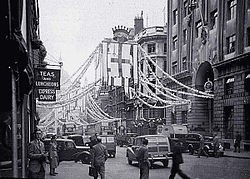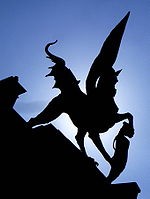Английский язык спецтексты для филологов
 Скачать 126.17 Kb. Скачать 126.17 Kb.
|
Lesson 5. Fleet StreetFleet Street is a street in the City of London named after the River Fleet, Lon- don's largest underground river. It was the home of British national newspapers until the 1980s. Even though the last major British news office, Reuters, left in 2005, the term Fleet Street continues to be used as a metonym for the British na- tional press. As early as the 13th century, it seems to have been known as Fleet Bridge Street, and in the early part of the 14th century it began to be mentioned frequent- ly by its present name, spelled, of course, in accordance with the customs of those days. Fleet Street began as the road from the commercial City of London to the political hub of Westminster. The length of Fleet Street marks the expansion of the City in the 14th century. At the east end of the street is where the River Fleet flowed against the medieval walls of London; at the west end is the Temple Bar which marks the current City of London/City of Westminster boundary, extended there in 1329. To the south lies an area of legal buildings known as the Temple, formerly the property of the Knights Templar, which at its core includes two of the four Inns of Court: the Inner Temple and the Middle Temple. There are many lawyers' offices (especially barristers' chambers) in the vicinity. Nearby, on Strand, are the Royal Courts of Justice and the Central Criminal Court on Old Bailey is also only a few minutes walk from Ludgate Circus.  Fleet Street pictured in 1952, with flags hung for the coronation of Queen Elizabeth II Publishing started in Fleet Street around 1500 when William Caxton's appren- tice, Wynkyn de Worde, set up a printing shop near Shoe Lane, while at around the same time Richard Pynson set up as publisher and printer next to St. Dunstan's church. More printers and publishers followed, mainly supplying the legal trade in the four Law Inns around the area. In March 1702, London's first daily newspa- per, the Daily Courant, was published in Fleet Street from premises above the White Hart Inn. At Temple Bar to the west, as Fleet Street crosses the boundary out of the City of London, it becomes the Strand; to the east, past Ludgate Circus, the route rises as Ludgate Hill. The nearest London Underground stations are Temple, Chancery Lane, and Blackfriars tube/ mainline station, and the City Thameslink railway sta- tion. For many years Fleet Street was especially noted for its taverns and coffee- houses. Many notable persons of literary and political fame used to frequent these, and a few, such as Ye Olde Cheshire Cheese, have survived to this day, in name at least. Along with St. Dunstan's, two other old London churches must also be mentioned as belonging to the Fleet Street region: Temple Church and St. Bride's have seen many notable processions. Wynkyn de Worde was buried in St. Bride's in 1535. In 1633, the church saw Samuel Pepys baptised. Many famous men are associated with Fleet Street, either by living there or in one of its many side streets, or by being regular frequenters of its taverns. Amongst these include Ben Jonson, John Milton, Izaak Walton, John Dryden, Samuel Johnson, Edmund Burke, Oliver Goldsmith and Charles Lamb. One of the most successful books ever written comes from Fleet Street: in 1786 at 46 Fleet Street there was published for the first time Baron Munchausen's Narrative of his Marvellous Travels and Campaigns, written anonymously by Rudolph Erich Raspe, printed by Smith and Kearsley. Fleet Street is also famous for the barber Sweeney Todd, traditionally said to have lived and worked in Fleet Street (he is sometimes called the 'Demon Barber of Fleet Street'). An early example of a serial killer, the character appears in vari- ous English language works starting in the mid-19th century. Neither the popular press, the Old Bailey trial records, the trade directories of the City nor the lists of the Barbers' Company mention any such person or indeed any such case. The west part of the street was destroyed by the Great Fire of London in 1666. The A4 road historically began at Ludgate Circus and the whole of Fleet Street was part of the route. However the A4 today begins at Holborn Circus, runs down Fetter Lane and then the western part of Fleet Street. It then continues west into Westminster. Contemporary Fleet StreetFleet Street is now more associated with the law and its Inns of Court and bar- risters' chambers, many of which are down alleys and around courtyards off Fleet Street itself, almost all of the newspapers thereabouts having moved east to Wap- ping and Canary Wharf. The former offices of The Daily Telegraph, drawn upon as a source by Evelyn Waugh in his comic novel Scoop, are now the London headquarters of the investment bank Goldman Sachs. C. Hoare & Co, England's oldest privately owned bank, has had its place of business here since 1690. The London office of D.C. Thomson & Co., creator of The Beano, is still based on Fleet Street. The Secretariat of the Commonwealth Broadcasting Asso- ciation is also an important Fleet Street address, at number 17. Since 1995 Fleet Street has been the home of Wentworth Publishing, an independent publisher of newsletters and courses. In 2006 the Press Gazette returned to Fleet Street, albeit only briefly. The Associated Press and The Jewish Chronicle remain close by. The Daily Telegraph and Sunday Telegraph have recently returned to the centre of London after having been downriver in Canary Wharf, but have not returned to Fleet Street. St Bride's Church, just off the eastern end of Fleet Street, remains the London church most associated with the print industry. A plaque in the church records the vigils held for journalists held hostage in Lebanon in the 1980s and 1990s, includ- ing John McCarthy and Terry Anderson. In the adjacent St. Brides Lane is the St Bride Library, specialising in the type and print industry. Several other news or publishing-related organisations are clustered on or close to Fleet Street. The British Association of Journalists is based at 89 Fleet Street; the Newspaper Society is nearby on St. Andrew Street; KM Group is at 75 Shoe Lane; and at number 76 is the London International Press Centre, home to TradeWinds, the international shipping news magazine, the Cartoonists' Club, and the International Broadcasting Convention. Metro International, publishers of the free newspaper Metro, are at 85 Fleet Street, while Meteor Press is at number 17. Other related businesses near Fleet Street include The Wall Street Journal in Fleet Place, the New Law Journal, the Perseus Books Group, Bowker UK, Motor Cycle News, the Worshipful Company of Stationers and Newspaper Makers, and the London Press Club. On the wall of Magpie Alley, off Bouverie Street, is a huge mural depicting the history of newspapers in the area.  The City's Dragon 'supporter' atop the present Temple Bar From Wikipedia, the free encyclopedia |
